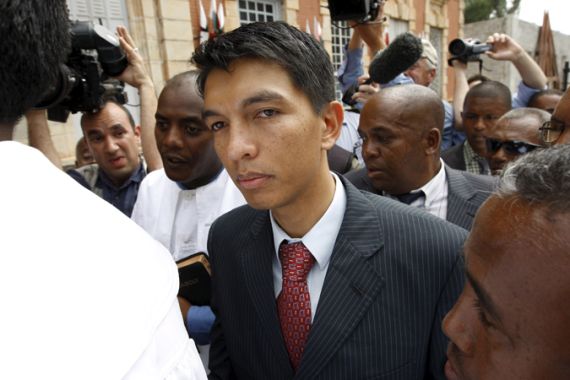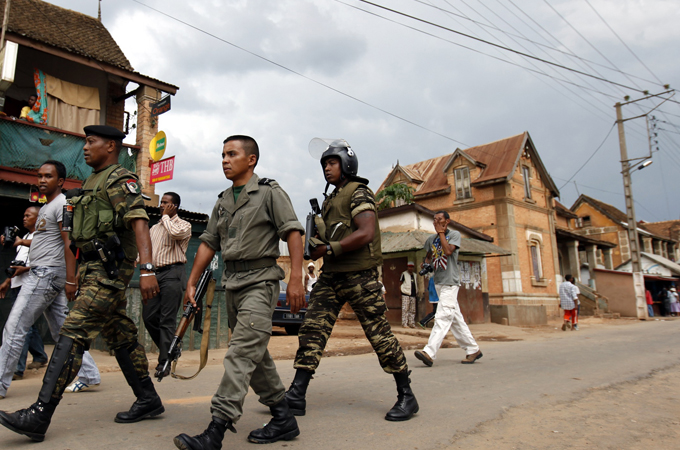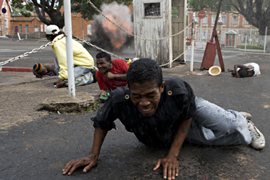Timeline: Madagascar crisis
Madagascan president and opposition leader locked in an at-times violent showdown.

 |
| Since 2009, Madagascar has experienced political crises attributed to coups and attempted takeovers [AFP] |
Madagascar has a history of political turmoil.
In the latest chapter, the country’s security forces stormed a base housing rebel soldiers, who previously declared a takeover from Andry Rajoeline, the president.
But in 2009, Rajoelina, a former opposition leader and mayor of the capital Antananarivo, also declared himself in-charge of the country and demanded Marc Ravalomanana, the then president, step down for misspending government funds.
The following are key events that have led to the country’s current political crisis:
December 2008: Viva TV – owned by opposition leader Andry Rajoelina – is shut down by authorities after airing an interview with Didier Ratsiraka, Madagascar’s exiled former president.
January 26, 2009: Violent demonstrations break out in the capital, Antananarivo. A teenager and a policeman are killed when protesters burn state-owned television and radio stations.
Rajoelina, also the mayor of the city, leads the protests, accusing the federal government of misspending funds and threatening democracy.
January 27-28: The charred remains of at least 37 people are found in a shop in Madagascar after it was burned and looted following the anti-government rally.
January 31: Rajoelina proclaims himself in-charge of the country.
February 1: The African Union (AU) says it will not support any attempt to overthrow Marc Ravalomanana, Madagascar’s president. Jean Ping, the AU head, says “any unconstitutional change of power will be condemned”.
February 3: The Madagascan government fires Rajoelina from his position as the mayor of Antananarivo.
February 7: At least 28 people are killed and hundreds injured when police open fire on a protest in Antananarivo. Rajoelina accuses the government of murdering civilians.
February 14: Madagascar’s president and opposition leader hold rival rallies in Antananarivo, roughly 1km apart, without major incident.
 |
| Police fired on anti-government protesters on February 7, killing dozens [AFP] |
February 16: Police fire warning shots to disperse up to 10,000 supporters of Rajoelina protesting against the government in the capital.
February 20: Madagascan security forces retake control of four key government ministries from opposition activists after they were seized a day earlier.
February 21: President Ravalomanana meets Rajoelina to try to resolve crisis, but no apparent progress made.
February 28: Rajoelina rallies 2,000 opposition supporters in Antananarivo.
March 6: At least two people die in clashes between opposition groups and police in Antananarivo amid government crackdown on supporters of Rajoelina.
March 8: Around 70 soldiers mutiny at a large military camp outside the Madagascan capital , saying they will defy government orders to repress civilians. The government says it is an internal army dispute.
March 10: General Edmond Rasolofomahandry, Madagascar’s army chief, issues a 72-hour ultimatum for the feuding political leaders to resolve their disputes or face military intervention.
March 11: General Rasolofomahandry is sacked as army chief and replaced by Andre Andriarijaona after “negotiations” among senior military officers.
March 13: Dissident soldiers claim to be deploying tanks in Antananarivo to intercept “mercenaries”.
March 14: Ravalomanana denies opposition claims that he has lost control of the government. The president issues a statement saying that the opposition does not have “the power bestowed by democratic elections” to take control.
March 15: Ravalomanana offers to hold a referendum to resolve the standoff between his government and opposition protesters.
March 16: Rajoelina calls on the security forces to arrest Ravalomanana. Madagascan troops seize the presidential palace compound and central bank in capital Antananarivo, and impose a curfew.
The president vows to fight to the death and appeals to the UN and southern African countries for military support.
March 17: Ravalomanana announces through a presidential spokesman that he has handed over control of the country to Hyppolite Ramaroson, a navy admiral and the most senior military official.
March 18: The military in turn, hands power to Rajoelina. After becoming leader in an army-backed overthrow of the president, he now heads a transitional government, and pledges to hold elections within two years.
Madagascar’s constitutional court issues a statement endorsing the takeover.
March 19: Mozambique, Angola and Swaziland, which make up the defence, political and security troika of the southern African bloc (Sadc), which includes Madagascar, refuse to recognise the new leader.
Norway, which gives at least $14 million a year in aid, says it has frozen funding.
March 20: The African Union suspends Madagascar and says it has six months to call an election. The United States says it is moving to suspend all non-humanitarian assistance to Madagascar.
March 21: Rajoelina is formally installed as president of Madagascar.
March 28: At least 34 people are injured during a sixth day of protests by Ravalomanana’s supporters.
March 30: The Southern African Development Community (Sadc) suspend Madagascar’s membership on the 15-member body and calls on Rajoelina to vacate the presidency.
November 16, 2010: Madagascar holds a referendum to accept or reject a new constitution that calls for keeping Rajoelina in power indefinitely.
November 16, 2010: Dissident soldiers attempt a coup on the same day. They declared that all government institutions were suspended and that a military council was in charge.
November 20, 2010: Security forces enter military base where rebel soldiers were holed up. They then give themselves up in an operation that ended quickly.